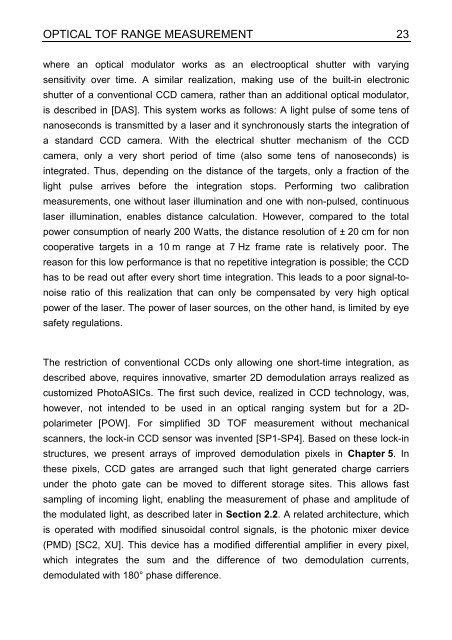3D Time-of-flight distance measurement with custom - Universität ...
3D Time-of-flight distance measurement with custom - Universität ...
3D Time-of-flight distance measurement with custom - Universität ...
Create successful ePaper yourself
Turn your PDF publications into a flip-book with our unique Google optimized e-Paper software.
OPTICAL TOF RANGE MEASUREMENT 23<br />
where an optical modulator works as an electrooptical shutter <strong>with</strong> varying<br />
sensitivity over time. A similar realization, making use <strong>of</strong> the built-in electronic<br />
shutter <strong>of</strong> a conventional CCD camera, rather than an additional optical modulator,<br />
is described in [DAS]. This system works as follows: A light pulse <strong>of</strong> some tens <strong>of</strong><br />
nanoseconds is transmitted by a laser and it synchronously starts the integration <strong>of</strong><br />
a standard CCD camera. With the electrical shutter mechanism <strong>of</strong> the CCD<br />
camera, only a very short period <strong>of</strong> time (also some tens <strong>of</strong> nanoseconds) is<br />
integrated. Thus, depending on the <strong>distance</strong> <strong>of</strong> the targets, only a fraction <strong>of</strong> the<br />
light pulse arrives before the integration stops. Performing two calibration<br />
<strong>measurement</strong>s, one <strong>with</strong>out laser illumination and one <strong>with</strong> non-pulsed, continuous<br />
laser illumination, enables <strong>distance</strong> calculation. However, compared to the total<br />
power consumption <strong>of</strong> nearly 200 Watts, the <strong>distance</strong> resolution <strong>of</strong> ± 20 cm for non<br />
cooperative targets in a 10 m range at 7 Hz frame rate is relatively poor. The<br />
reason for this low performance is that no repetitive integration is possible; the CCD<br />
has to be read out after every short time integration. This leads to a poor signal-tonoise<br />
ratio <strong>of</strong> this realization that can only be compensated by very high optical<br />
power <strong>of</strong> the laser. The power <strong>of</strong> laser sources, on the other hand, is limited by eye<br />
safety regulations.<br />
The restriction <strong>of</strong> conventional CCDs only allowing one short-time integration, as<br />
described above, requires innovative, smarter 2D demodulation arrays realized as<br />
<strong>custom</strong>ized PhotoASICs. The first such device, realized in CCD technology, was,<br />
however, not intended to be used in an optical ranging system but for a 2Dpolarimeter<br />
[POW]. For simplified <strong>3D</strong> TOF <strong>measurement</strong> <strong>with</strong>out mechanical<br />
scanners, the lock-in CCD sensor was invented [SP1-SP4]. Based on these lock-in<br />
structures, we present arrays <strong>of</strong> improved demodulation pixels in Chapter 5. In<br />
these pixels, CCD gates are arranged such that light generated charge carriers<br />
under the photo gate can be moved to different storage sites. This allows fast<br />
sampling <strong>of</strong> incoming light, enabling the <strong>measurement</strong> <strong>of</strong> phase and amplitude <strong>of</strong><br />
the modulated light, as described later in Section 2.2. A related architecture, which<br />
is operated <strong>with</strong> modified sinusoidal control signals, is the photonic mixer device<br />
(PMD) [SC2, XU]. This device has a modified differential amplifier in every pixel,<br />
which integrates the sum and the difference <strong>of</strong> two demodulation currents,<br />
demodulated <strong>with</strong> 180° phase difference.

















